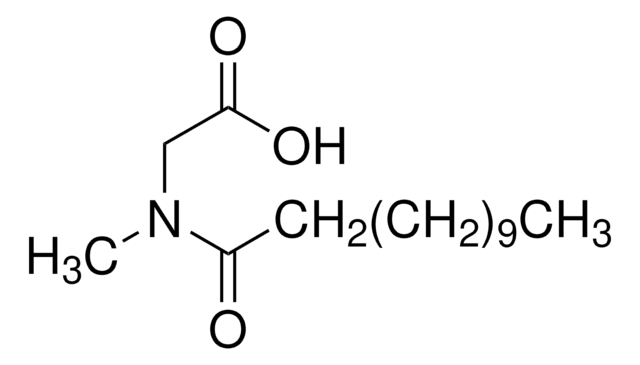Key Documents
61739
N-Lauroylsarcosine
purum p.a., ≥98.0% (GC)
Synonim(y):
N-Dodecanoyl-N-methylglycine, Sarkosyl L
About This Item
Polecane produkty
opis
anionic
Poziom jakości
klasa czystości
purum p.a.
Próba
≥98.0% (GC)
masa cząsteczkowa
271.40 g/mol
metody
protein quantification: suitable
zanieczyszczenia
≤0.2% water
pozostałość po prażeniu
≤0.1%
mp
45-50 °C
ślady anionów
chloride (Cl-): ≤50 mg/kg
sulfate (SO42-): ≤100 mg/kg
ślady kationów
Ca: ≤20 mg/kg
Cd: ≤5 mg/kg
Co: ≤5 mg/kg
Cr: ≤5 mg/kg
Cu: ≤5 mg/kg
Fe: ≤10 mg/kg
K: ≤70 mg/kg
Mg: ≤5 mg/kg
Mn: ≤5 mg/kg
Na: ≤200 mg/kg
Ni: ≤5 mg/kg
Pb: ≤5 mg/kg
Zn: ≤20 mg/kg
ciąg SMILES
CCCCCCCCCCCC(=O)N(C)CC(O)=O
InChI
1S/C15H29NO3/c1-3-4-5-6-7-8-9-10-11-12-14(17)16(2)13-15(18)19/h3-13H2,1-2H3,(H,18,19)
Klucz InChI
BACYUWVYYTXETD-UHFFFAOYSA-N
Szukasz podobnych produktów? Odwiedź Przewodnik dotyczący porównywania produktów
Opis ogólny
Zastosowanie
Hasło ostrzegawcze
Danger
Zwroty wskazujące rodzaj zagrożenia
Zwroty wskazujące środki ostrożności
Klasyfikacja zagrożeń
Acute Tox. 2 Inhalation - Eye Dam. 1 - Skin Irrit. 2
Kod klasy składowania
6.1A - Combustible acute toxic Cat. 1 and 2 / very toxic hazardous materials
Klasa zagrożenia wodnego (WGK)
WGK 1
Temperatura zapłonu (°F)
Not applicable
Temperatura zapłonu (°C)
Not applicable
Środki ochrony indywidualnej
dust mask type N95 (US), Eyeshields, Gloves
Wybierz jedną z najnowszych wersji:
Masz już ten produkt?
Dokumenty związane z niedawno zakupionymi produktami zostały zamieszczone w Bibliotece dokumentów.
Klienci oglądali również te produkty
Nasz zespół naukowców ma doświadczenie we wszystkich obszarach badań, w tym w naukach przyrodniczych, materiałoznawstwie, syntezie chemicznej, chromatografii, analityce i wielu innych dziedzinach.
Skontaktuj się z zespołem ds. pomocy technicznej








